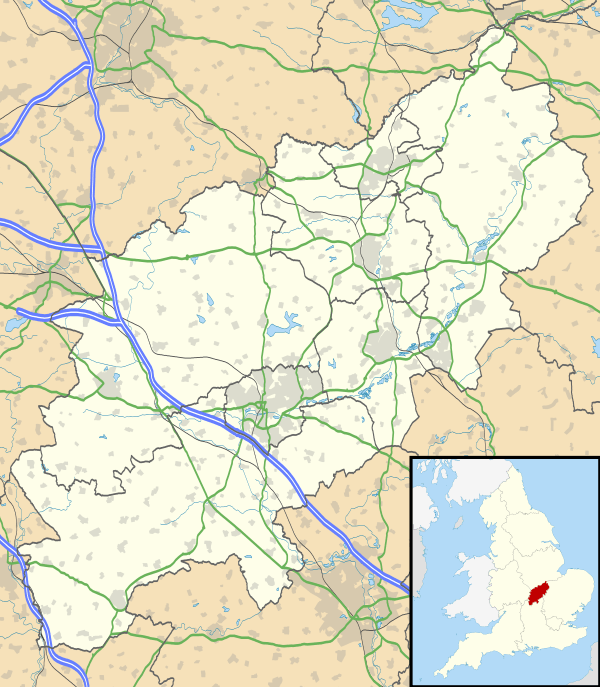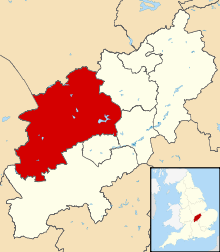Boughton, Northamptonshire
| Boughton | |
%2C_Boughton.jpg) Church of St John the Baptist |
|
 Boughton |
|
| Population | 1,112 (2011 Census) |
|---|---|
| OS grid reference | SP753659 |
| – London | 72 miles (116 km) |
| District | Daventry |
| Shire county | Northamptonshire |
| Region | East Midlands |
| Country | England |
| Sovereign state | United Kingdom |
| Post town | Northampton |
| Postcode district | NN2 |
| Dialling code | 01604 |
| Police | Northamptonshire |
| Fire | Northamptonshire |
| Ambulance | East Midlands |
| EU Parliament | East Midlands |
| UK Parliament | Daventry |
|
|
Coordinates: 52°17′10″N 0°53′51″W / 52.28609°N 0.89753°W
Boughton is a village and civil parish in the Daventry district of Northamptonshire, England, about 4 miles (6.4 km) from Northampton town centre along the A508 road between Northampton and Market Harborough. The parish area straddles both side of the road but the main part of the village is east. It is on the northern fringe of the Northampton urban area and, together with the neighbouring village of Moulton is in the preferred area for the expansion of the town.
Demographics
The 2001 census shows a population of 951, 459 male and 492 female in 369 dwellings,[1] increasing to 1,112 at the 2011 census.[2]
Governance
Boughton Parish Council has 9 members elected every 4 years. The local authority is Daventry District Council and the village is part of Northamptonshire County Council.
Buildings
Boughton Park lies between the village and the A508 road. It has a notable collection of 18th and 19th century follies, including The Spectacles (twin towers with a Gothic arch), Bunkers Hill Farm (1776), New Park Barn (1770) which resembles a fortified castle[3] (now called Fox Covert Hall and converted into a house) and the castellated Hawking Tower (1756 or earlier),[3] the main gate lodge on east side of the A508 main road. There is also a grotto north of the house and an obelisk to the south (1764)[3] near Obelisk Rise, a large 1960s housing estate in Northampton. The follies were built by William Wentworth, 2nd Earl of Strafford (1722–1791), a friend of Horace Walpole in the late 18th century. The setting of the follies may be affected by the proposed construction of Northampton's northern ring-road and the expansion of the town.
Boughton Hall was the home of the Wentworth family although the original hall has gone.[4] The current house dates from 1844 in the Tudor style.
Holly Lodge lies just outside the park and is not strictly a folly but a house made to mimic the follies themselves. It is close to The Spectacles and built by Northampton architect Alexander Milne in 1857-61 for chemist Philadelphus Jeyes whose younger brother John found the chain of pharmacies and was famous as the inventor of Jeyes Fluid.[3]
St John's Church surviving fragments are to the north of the Green. The church has been in ruins since at least 1757,[5] and was significantly damaged further in 1784 when the spire collapsed.[4] The current church of St John Baptist is in the village and believed to date from c.1350, with extensions in 1807 and 1874.[4] It has a monument to Mary Tillemont (d.1706).
Boughton Primary School is in Moulton Road. The original school building of 1841 is to the north of the church tower.[4]
Boughton House, a stately home also in Northamptonshire, is located to the north of Kettering, approximately 20 miles (32 km) away and not connected to this village.
Other details
The infamous highwayman, "Captain Slash" was detained whilst attempting robbery at Boughton Fayre which was situated on Boughton Green, now a large agricultural triangle on the Moulton road. He was subsequently tried and hanged in Northampton before a large crowd of onlookers on 21 July 1826.[6] His ghost is reputed to haunt the area.[7]
References
- ↑ 2001 Census data at the Office for National Statistics
- ↑ "Civil Parish population 2011". Neighbourhood Statistics. Office for National SAtatistics. Retrieved 29 June 2016.
- 1 2 3 4 Timothy Mowl; Clare Hickman (2008). The Historic Gardens of England, Northamptonshire. Stroud, Gloucestershire: Tempus Publishing. pp. 95–8. ISBN 978-0-7524-4568-7.
- 1 2 3 4 Pevsner, Nikolaus; Cherry, Bridget (revision) (1961). The Buildings of England – Northamptonshire. London and New Haven: Yale University Press. pp. 109–10. ISBN 978-0-300-09632-3.
- ↑ Select and Remarkable Epitaphs, Vol 1, p. 146. First printed in London, 1757
- ↑ Northamptonshire Police Museum Archived 4 June 2008 at the Wayback Machine.
- ↑ Croft, Richard (10 August 2011). "Boughton Green (C) Richard Croft :: Geograph Britain and Ireland". Geograph Britain and Ireland. Retrieved 29 August 2014.
External links
| Wikimedia Commons has media related to Boughton, Northamptonshire. |
